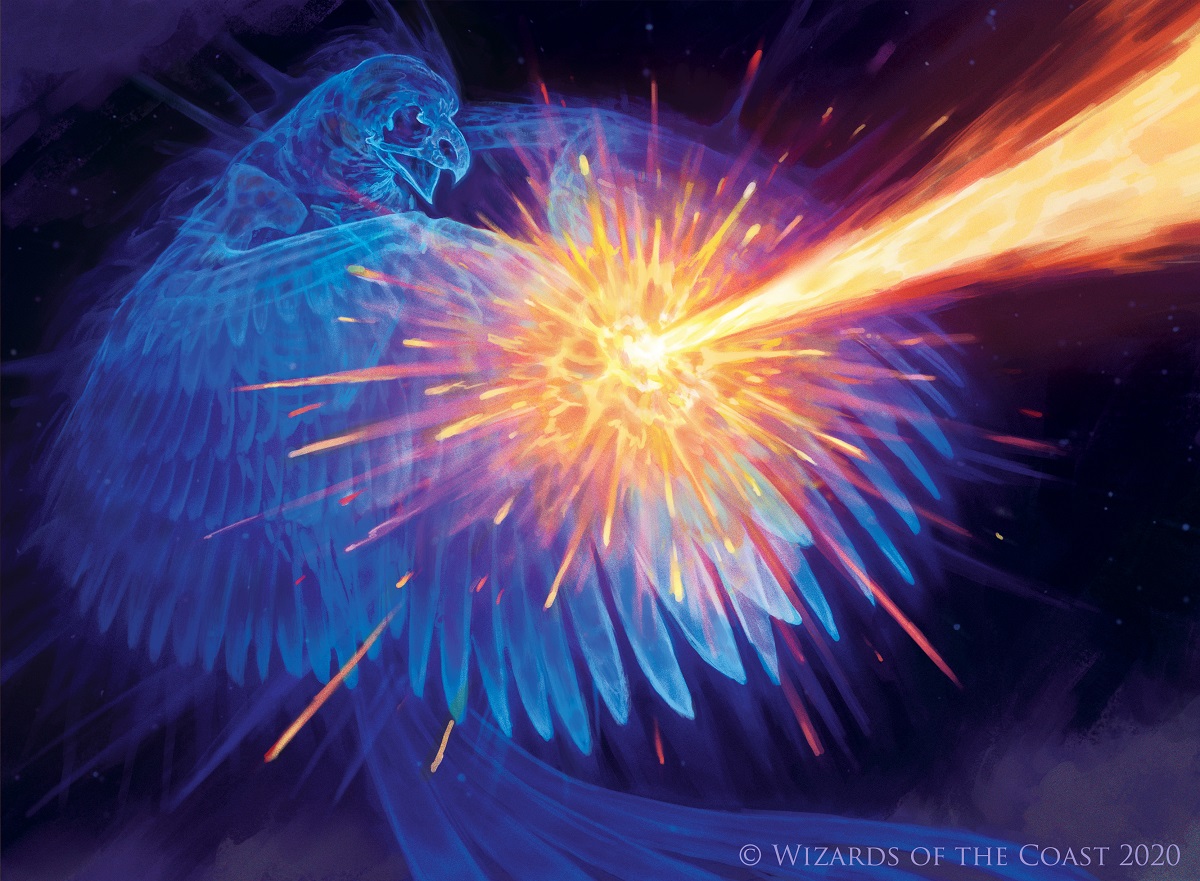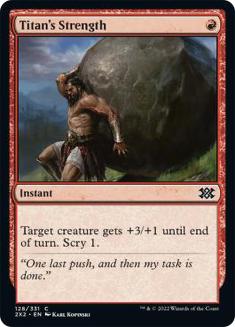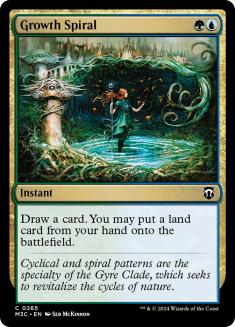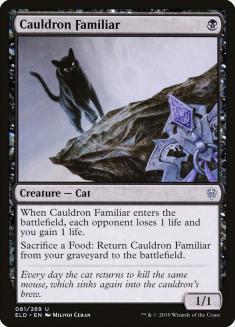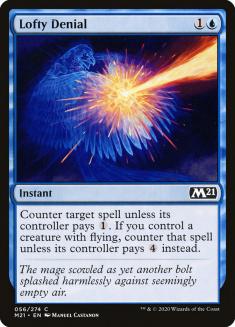Finally.
That was my first reaction upon waking Monday morning. Magic has labored under the weight of some of the best and most oppressive cards we have ever seen for over a year now. Despite sets deep with powerful cards, Standard deckbuilding has been more about what you can’t do than what you can do. Now, with Growth Spiral; Wilderness Reclamation; Teferi, Time Raveler; and Cauldron Familiar cast aside, it feels like we’ve got a chance at a fresh start.
But where to begin? With Standard at its largest possible size, rewriting the metagame from the ground up feels like a Herculean task (and with rotation just around the corner, maybe a little Sisyphean as well).
There are a few reasonable starting points. First, you could simply identify the decks that survived the bannings unscathed. There are a few decks that only recently established themselves in the top tier such as Mardu Winota and Mono-Black Aggro that completely brush off these changes. Both are fine choices for Week 1, but choosing a deck in this fashion ignores the tremendous pressure that the banned cards were exerting on the other decks in the format. There are going to be many cards returning to decks, including spot removal options, that could decrease the effectiveness of these existing strategies.
You could do a deep dive on all the Standard-legal options to try and pinpoint the individual cards that haven’t had a chance to shine thus far. This sounds like a lot of fun and I may even do this in a future article, but one of these underappreciated gems becoming the basis of the new best deck simply because you will it to be so is highly unlikely. This skips tons of context and ignores the enormously powerful single-card options left behind that were already a successful part of the metagame like Uro, Titan of Nature’s Wrath and Nissa, Who Shakes the World.
Instead, I’d like to try painting with a broader brush. Each of these four bans had strategies they were propping up and strategies they were holding down. By defining the gains and losses as format-wide macro-trends rather than alterations to specific decks, I can start to make reasonable conclusions about the state of the Week 1 metagame. These conclusions have led me to a couple of deck options that I believe hold real promise for those of you looking to put together a run in this weekend’s Standard Championship Qualifier.
For months, the idea of playing on-curve has been mostly laughable. Only decks capable of recouping mana advantage through some overpowered engine would even dream of keeping pace with the Growth Spiral decks. Furthermore, cheating on lands in any deck was simply not an option. If your Growth Spiraling opponent was going to play 28 lands and never miss a drop, you were priced into the demanding the same level of consistency from your deck.
You can argue that this realization is more akin to an upgrade of the universal heuristics used by Magic players rather than a noteworthy consequence of Growth Spiral, but we’ll need some time to see where the hive mind now settles on land counts. My advice—don’t trend downwards too aggressively. Spells are still more powerful than those of an average Standard format, and you’re still extremely incentivized to try to let your game-winners carry games.
When it comes to attacking ramp decks, does losing the cantripping ramp of Growth Spiral mean it’s now possible for these decks to run out of meaningful spells during a game? Can we take the classic tactic of just challenging the ramp decks; payoffs? Sadly, the answer still seems to be no. Cultivate, Llanowar Visionary, Risen Reef, Cavalier of Thorns… There are still plenty of ways for decks to get big without spending cards on doing so.
Furthermore, Uro and Hydroid Krasis remain payoffs with snowballing card advantage stapled on. This suggests to me that pure control is still apt to struggle in these matchups. Traditional control decks built around Thought Erasure and countermagic like Esper Control or Grixis Control are no closer to viability. Closing games remains critical.
With the expulsion of Wilderness Reclamation from the format, there is going to be a desire to return to Magic as it once was. Think threats, answers, and a cute trick or two a la Guilds of Ravnica-era Golgari Midrange. Players have had their fill of engines, and it’s a comforting dream to believe in a world where I can kill your creature and then cast a good, solid three-drop like Radha, Heart of Keld and slowly pull ahead.
Sorry.
Creatures (15)
Planeswalkers (3)
Lands (35)
Spells (27)
- 2 Kaya's Wrath
- 4 Oath of Kaya
- 4 Doom Foretold
- 3 Glass Casket
- 4 Treacherous Blessing
- 4 Agonizing Remorse
- 3 Elspeth Conquers Death
- 3 Heartless Act
Sideboard

Creatures (26)
- 4 Lovestruck Beast
- 4 Beanstalk Giant
- 4 Edgewall Innkeeper
- 4 Bonecrusher Giant
- 4 Fae of Wishes
- 4 Brazen Borrower
- 2 Radha, Heart of Keld
Lands (27)
Spells (7)

These are just the two obvious holdovers from the last format. With Wilderness Reclamation leaving, is there reason to play Titans’ Nest or Song of Creation, or to flicker Frilled Mystics with Escape Protocol? Maybe Zenith Flare in and of itself deserves credit as an engine?
The point is, just because the outlier engines like Fires of Invention and Wilderness Reclamation have finally met their deaths, don’t convince yourself we are back in the world of 2018 Magic. Decks do absurdly powerful things as games go long, and midrange tap-out threats like Arclight Phoenix or Doom Whisperer remain just as invalidated as ever. Look to either win games in tight windows, or make sure your scaling can hang.
Cauldron Familiar made the idea of attacking with an average creature laughable, and its good friend Priest of Forgotten Gods happily punished any investment into a singular threat. Meanwhile, Mayhem Devil was happy to cut out the legs of anyone going wide. This trio was the reason creature combat left the game for the past year.
This setup also invalidated the very concept of playing removal. In a metagame that cared about controlling creatures, I’d just play Rakdos or Jund Sacrifice which dealt with opposing battlefields almost as a bonus effect upon setting up its core engine.
While this ban opens more space than the aforementioned ones, it does behoove us to realize that the freerolls gained in a metagame that rarely saw a removal spell are now gone. I’d expect Mardu Winota to have to start beating some Heartless Acts along the way.
In my opinion, Teferi, Time Raveler is the ban that will alter Standard the most. Much has been said about how difficult it is to play a creature that doesn’t have immediate impact in the time of Teferi. While this was true, I don’t expect this point to change all that much.
Brazen Borrower is a Legacy-quality card that has had its impact limited by Teferi’s static ability. I expect a dramatic increase in the number of Brazen Borrowers and Petty Thefts being cast, and this alongside more spot removal leads me to believe that were not on the cusp of a format ruled by Elder Gargaroth and Baneslayer Angel.
The true impactful change from Teferi’s absence will be a return to hard countermagic that can punish an opponent investing large amount of mana in a threat or engine piece. The cost of a resolved Teferi to any deck attempting to temporarily disrupt an opponent and close a game in the middle range of turns was just too high to ever take the deckbuilding risk. An entire range of games was exiled from the metagame. In a Teferi-less world, there must be space for a deck that can leverage countermagic to create small mid-game windows in which to win with evasive damage.
This is the path through which Standard can be legitimately turned on its ear. If these decks find success, it incentivizes decks to look to cheaper permanents to find success, and haymaker Magic can be put to rest after months of it being inescapable.
In my eyes, the key to all of this is Lofty Denial. This is one of the better two-mana counters the game has seen in a long time. Still, the card’s effectiveness has a shelf life, and even the empowered mode will eventually be outscaled by the haymaker villains of the format. This is why it’s so vitally important that our decks built around countermagic retain the capability to close games.
Creatures (23)
- 4 Spectral Sailor
- 1 Faerie Vandal
- 3 Bonecrusher Giant
- 4 Brazen Borrower
- 4 Sprite Dragon
- 3 Lore Drakkis
- 4 Sea-Dasher Octopus
Lands (24)
Spells (13)
Sideboard

After a brief dalliance with Lore Drakkis in the Ikoria release window, I was convinced I’d never have cause to return to the card. Priest of Forgotten Gods was just such a hard punish, and Teferi, Time Raveler meant the countermagic you wanted to rebuy was dead half the time anyway. This take feels promising though.
If you’re not in on the joke, there are some loops you can set up with enough Lore Drakkis, mutators, and Unsummons, but that’s rarely going to be the main goal here. You’re just a solid tempo deck that uses and rebuys enough countermagic to force your opponents off their best spells. Brazen Borrower ascends to its throne here as one of the best cards in new Standard. Seriously, I expect this card to show up everywhere and exploit people who think they have the green light for expensive permanents.
Frantic Inventory is likely a surprise inclusion over Opt, but most scenarios involve you holding open two mana for Lofty Denial anyway—may as well play the card draw with upside. Same goes for the surprisingly good Faerie Vandal. With it and Sprite Dragon, you’ve got a bunch of cards that lean into the early-game snowballs you’re looking to create.
I will admit though, while this deck is solid and a blast to play, it very much reminds me of the old days, and that’s not a good thing. When you’re playing cards like Faerie Vandal in 2020 you’re always fooling yourself to some extent. I want to believe you can build around gameplans, but you can’t just ignore power.
I’ve tinkered with some ways to include more powerful options including the combination of Finale of Promise and See the Truth, but the last thing I want to do is attempt playing an Izzet deck at sorcery speed again. We’ve done this with the release of every set. It didn’t work then, and nothing has changed to make it work now.
I came across a list from Noxious that I thought did a nice job of shoehorning in some of the more powerful options in the color combination while holding on to the draw of Lofty Denial.
Creatures (19)
Planeswalkers (2)
Lands (24)
Spells (15)
Sideboard

There’s space to flesh out both ideas more, and I’m curious to see where the Izzet decks end up. In the meantime, may as well keep playing Simic cards until someone takes them away from you.
Creatures (23)
- 3 Hydroid Krasis
- 2 Frilled Mystic
- 3 Paradise Druid
- 2 Spectral Sailor
- 4 Nightpack Ambusher
- 4 Gilded Goose
- 4 Brazen Borrower
- 1 Uro, Titan of Nature's Wrath
Planeswalkers (3)
Lands (26)
Spells (8)
Sideboard

The power concerns present with the last deck are just obliterated here. We’ve got all the all-stars they still let us play with. Nissa, Who Shakes the World fueling the two powerful X-spells will be a thing until this format is done. The cards just bulldoze through too many strategies.
The really exciting part of this deck to me is using Gilded Goose to enable Lofty Denial. We’ve got a total of fifteen flyers if we count Shark tokens, and I think that is plenty to get us a viable late-game counterspell, We’re definitely going to find some Turn 4 Nissas with countermagic backup as well. I love the Turn 1 Gilded Goose, Turn 2 Lofty Denial, Turn 3 Nightpack Ambusher games, and if you want to get truly degenerate, you can even throw a Rewind in the mix.
If this deck has a hole right now, it’s snowballing cheap creatures like Edgewall Innkeeper. I added some Primal Might to the sideboard for exactly that reason, but it’s a thin out, and I wonder if there is a Temur or Sultai version of this deck that picks up some quality removal.
Overall, I’m cautiously optimistic about this new Standard. I think people are overstating how much things have really changed though. We can’t expect to find success with full regression to 2018 deckbuilding heuristics. Don’t lose sight of the engines that had to play second fiddle to Wilderness Reclamation and Fires of Invention. We’re a long way from good ol’ threats-and-answers Magic, even if we got to take some merciful baby steps closer.

